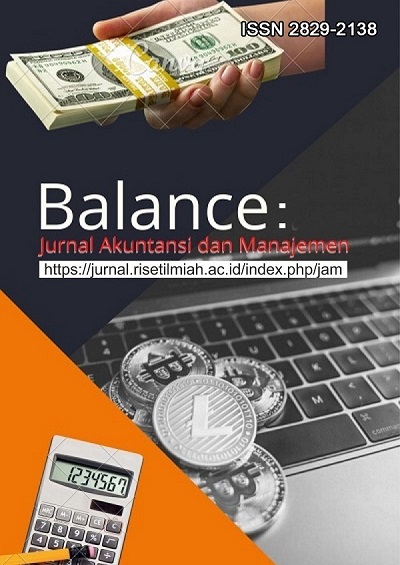Determinants of Poverty in Indonesia: A Dynamic Panel Analysis of Economic and Social Factors across 20 Provinces
DOI:
https://doi.org/10.59086/jam.v3i3.609Keywords:
VECM, Poverty, Fiscal Policy, GDP, FDIAbstract
Downloads
References
Abrar, M., Juanda, B., Firdaus, M., & Hakim, D. B. (2020). The Impact of Special Autonomy Funds on Poverty of Human Development and Unemployment in Aceh. International Journal of Innovation, Creativity and Change, 12(10), 713-734.
Agarwal, M., Atri, P., & Kundu, S. (2017). Foreign direct investment and poverty reduction: India in regional context. South Asia Economic Journal, 18(2), 135-157. https://doi.org/10.1177/1391561417713129
Ahmad, F., Draz, M. U., Su, L., Ozturk, I., Rauf, A., & Ali, S. (2019). Impact of FDI inflows on poverty reduction in the ASEAN and SAARC economies. Sustainability, 11(9), 2565. https://doi.org/10.3390/su11092565
Alonzo, R. P., Balisacan, A., Canlas, D., Capuno, J., Clarete, R., Danao, R., ... & Tecson, G. (2004). Population and poverty: the real score. University of the Philippines, School of Economics.
Amakom, U. (2020). Public spending and poverty reduction in Nigeria: A benefit incidence analysis in education and health (Doctoral dissertation, AERC).
Anetor, F. O., Esho, E., & Verhoef, G. (2020). The impact of foreign direct investment, foreign aid and trade on poverty reduction: Evidence from Sub-Saharan African countries. Cogent Economics & Finance, 8(1), 1737347. https://doi.org/10.1080/23322039.2020.1737347
Bado, B., Alam, S., & Cahyani, A. (2019, March). The Effect Of Government Admission on Poverty In The City of Makassar: 2000-2017. In First International Conference on Materials Engineering and Management-Management Section (ICMEMm 2018) (pp. 127-130). Atlantis Press.
Baltagi, B. H., & Baltagi, B. H. (2021). Dynamic panel data models. Econometric analysis of panel data, 187-228.
Basuki, A. T., & Prawoto, N. (2019). Analisis Regresi: dalam Penelitian Ekonomi dan Bisni. Depok: Rajagrafindo Persada.
Cahyo, B. D., Setyowati, A. S., & Prabowo, A. (2022). Pearson Correlation Between Education Level and Population Growth on Poverty in Central Java, 2019-2021. International Journal of Business, Economics, and Social Development, 3(4), 174-180. https://doi.org/10.46336/ijbesd.v3i4.349
CHO, E. E. (2021). Paths out of poverty: International experience. Journal of Integrative Agriculture, 20(4), 857-867. https://doi.org/10.1016/S2095-3119(20)63295-6
Cruz, M., & Ahmed, S. A. (2018). On the impact of demographic change on economic growth and poverty. World development, 105, 95-106.
Das Gupta, M. (2014). Population, poverty, and climate change. The World Bank Research Observer, 29(1), 83-108.
Dissou, Y., Didic, S., & Yakautsava, T. (2016). Government spending on education, human capital accumulation, and growth. Economic Modelling, 58, 9-21. https://doi.org/10.1016/j.econmod.2016.04.015
Duruh, B. & Chima, C. (2022). Impact of education budget on poverty reduction in Nigeria. J Econ Allied Res, 7(4), 150-163.
Ganić, M. (2019). Does foreign direct investment (FDI) contribute to poverty reduction? Empirical evidence from Central European and Western Balkan countries. Scientific Annals of Economics and Business, 66(1), 15-27. https://doi.org/10.2478/saeb-2019-0003
Grant, C. (2017). The contribution of education to economic growth.
Gujarati, D. N. (2021). Essentials of econometrics. Sage Publications.
Hassan, O. M. (2015). The impact of the growth rate of the gross domestic product (GDP) on poverty reduction in Nigeria. Journal of Emerging Trends in Economics and Management Sciences, 6(3), 221-230. https://hdl.handle.net/10520/EJC178636
Johansen, S. (2014). Times Series: Cointegration.
Magombeyi, M. T., & Odhiambo, N. M. (2017). Foreign direct investment and poverty reduction. Comparative Economic Research. Central and Eastern Europe, 20(2), 73-89. https://doi.org/10.1515/cer-2017-0013
Makarenko, E., Nivorozhkina, L., Tregubova, A., Toropova, T., & Nazarova, E. (2022). Risk of increasing income inequality and poverty: analysis by income source. Sustainability, 14(3), 1610. https://doi.org/10.3390/su14031610
Misini, S., & Badivuku-Pantina, M. (2017). The effect of economic growth under nominal GDP in relation to poverty. Romanian Economic Journal, 20(63), 104-116.
Murjani, A. (2019). Short-run and long-run impact of inflation, unemployment, and economic growth towards poverty in Indonesia: ARDL approach. Jurnal Dinamika Ekonomi Pembangunan, 2(1), 15-29. https://doi.org/10.14710/jdep.2.1.15-29
Nguyen, H. T. T., NGUYEN, C. V., & NGUYEN, C. V. (2020). The effect of economic growth and urbanization on poverty reduction in Vietnam. The Journal of Asian Finance, Economics and Business, 7(7), 229-239. http://dx.doi.org/10.13106/jafeb.2020.vol7.no7.229
Ninu, A. & Hutabarat, D. (2024). Impact of Own-Source, General, and Special allocation Funds on Poverty in East Nusa Tenggara. Jurnal Ilmu Ekonomi dan Pembangunan, 24(1), 44-49. https://doi.org/10.20961/jiep.v24i1.75740
Nkurunziza, J., Broekhuis, A., & Hooimeijer, P. (2017). Do poverty reduction programmes foster education expenditure? New evidence from Rwanda. Journal of Asian and African Studies, 52(4), 425-443. https://doi.org/10.1177/0021909615595988
Odior, E. S. O. (2014). Government Expenditure on education and poverty reduction: implications for achieving the MDGs in Nigeria, a computable general equilibrium micro-simulation analysis. https://ir.unilag.edu.ng/handle/123456789/8292
Pesaran, M. H., & Shin, Y. (1995). An autoregressive distributed lag modelling approach to cointegration analysis (Vol. 9514, pp. 371-413). Cambridge, UK: Department of Applied Economics, University of Cambridge. https://doi.org/10.1017/CCOL0521633230.011
Pesaran, M. H., & Smith, R. P. (2019). A Bayesian analysis of linear regression models with highly collinear regressors. Econometrics and Statistics, 11, 1-21. https://doi.org/10.1016/j.ecosta.2018.10.001
Peterson, E. W. F. (2017). The role of population in economic growth. Sage Open, 7(4), 2158244017736094. https://doi.org/10.1177/2158244017736094
Putra, H. S. (2017). The Linkage of Intergovernmental Transfer and Poverty in Indonesia. Jurnal Bina Praja, 9(1), 29-40. https://doi.org/10.21787/jbp.09.2017.29-40
Roshaniza, N. A. B. M., & Selvaratnam, D. P. (2015). Gross domestic product (GDP) relationship with human development index (HDI) and poverty rate in Malaysia. Prosiding Perkem, 10, 211-217.
Saleem, H., Shabbir, M. S., Shah, S. A. R., & Shah, J. (2021). Nexus between foreign direct investment and poverty reduction: A case of Pakistan. iRASD Journal of Economics, 3(3), 272-280. https://doi.org/10.52131/joe.2021.0303.0043
Seo, M. (2006). Bootstrap testing for the null of no cointegration in a threshold vector error correction model. Journal of Econometrics, 134(1), 129-150. https://doi.org/10.1016/j.jeconom.2005.06.018
Shahbaz, M. (2012). Does trade openness affect long run growth? Cointegration, causality and forecast error variance decomposition tests for Pakistan. Economic Modelling, 29(6), 2325-2339. https://doi.org/10.1016/j.econmod.2012.07.015
Sulasmi, E., Prasetia, I., & Rahman, A. A. (2023). Government Policy Regarding Education Budget on The Posture of The State Budget (APBN). Journal for Lesson and Learning Studies, 6(1), 142-151. https://doi.org/10.23887/jlls.v6i1.60171
Suryahadi, A., Hadiwidjaja, G., & Sumarto, S. (2012). Economic growth and poverty reduction in Indonesia before and after the Asian financial crisis. Bulletin of Indonesian economic studies, 48(2), 209-227. https://doi.org/10.1080/00074918.2012.694155
Todaro, M. P., & Smith, S. C. (2009). Economic development. Pearson education.
Tsaurai, K. (2018). Investigating the impact of foreign direct investment on poverty reduction efforts in Africa. Revista Galega de Economía, 27(2), 139-154. https://doi.org/10.15304/rge.27.2.5664
Wietzke, F. B. (2020). Poverty, inequality, and fertility: the contribution of demographic change to global poverty reduction. Population and Development Review, 46(1), 65-99. https://doi.org/10.1111/padr.12317
Wooldridge, J. M. (2016). Introductory Econometrics: A Modern Approach 6rd ed. Cengage learning.
Zhu, Y., Bashir, S., & Marie, M. (2022). Assessing the relationship between poverty and economic growth: does sustainable development goal can be achieved? Environmental Science and Pollution Research, 29(19), 27613-27623. https://doi.org/10.1007/s11356-021-18240-5
Downloads
Published
How to Cite
Issue
Section
License
Copyright (c) 2024 Nano Prawoto

This work is licensed under a Creative Commons Attribution 4.0 International License.
This is an open-access journal. All works are published under the Creative Commons license CC-BY which means that all content is freely available at no charge to the user or his/her Institution. Users are allowed to read, download, copy, write, improve, and create derivative creation even for other lawful purposes, this license permits anyone to, as long as they cite and license the derivative creation under similar terms

This work is licensed under a Creative Commons Attribution 4.0 International License.
Similar Articles
- Nano Prawoto, Economic Factors Affecting Imports Per Capita in Indonesia: Empirical Evidence from the Error Correction Model , Balance : Jurnal Akuntansi dan Manajemen: Vol. 4 No. 1 (2025): April 2025
You may also start an advanced similarity search for this article.
Most read articles by the same author(s)
- Nano Prawoto, Economic Factors Affecting Imports Per Capita in Indonesia: Empirical Evidence from the Error Correction Model , Balance : Jurnal Akuntansi dan Manajemen: Vol. 4 No. 1 (2025): April 2025


















